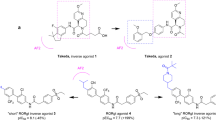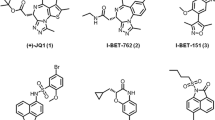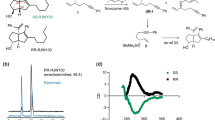Abstract
The retinoic acid receptor-related orphan receptor γ (RORγ) is regarded as an attractive therapeutic target for the treatment of prostate cancer. Herein, we report the identification, optimization, and evaluation of 1,2,3,4-tetrahydroquinoline derivatives as novel RORγ inverse agonists, starting from high throughput screening using a thermal stability shift assay (TSA). The representative compounds 13e (designated as XY039) and 14a (designated as XY077) effectively inhibited the RORγ transcriptional activity and exhibited excellent selectivity against other nuclear receptor subtypes. The structural basis for their inhibitory potency was elucidated through the crystallographic study of RORγ LBD complex with 13e. Both 13e and 14a demonstrated reasonable antiproliferative activity, potently inhibited colony formation and the expression of AR, AR regulated genes, and other oncogene in AR positive prostate cancer cell lines. Moreover, 13e and 14a effectively suppressed tumor growth in a 22Rv1 xenograft tumor model in mice. This work provides new and valuable lead compounds for further development of drugs against prostate cancer.

This is a preview of subscription content, access via your institution
Access options
Subscribe to this journal
Receive 12 print issues and online access
$259.00 per year
only $21.58 per issue
Buy this article
- Purchase on Springer Link
- Instant access to full article PDF
Prices may be subject to local taxes which are calculated during checkout









Similar content being viewed by others
References
Jetten AM, Ueda E. Retinoid-related orphan receptors (RORs): roles in cell survival, differentiation and disease. Cell Death Differ. 2002;9:1167–71.
Zhang Y, Luo XY, Wu DH, Xu Y. ROR nuclear receptors: structures, related diseases, and drug discovery. Acta Pharmacol Sin. 2015;36:71–87.
Fauber BP, Magnuson S. Modulators of the nuclear receptor retinoic acid receptor-related orphan receptor-γ (RORγ or RORc). J Med Chem. 2014;57:5871–92.
Huang M, Bolin S, Miller H, Ng HL. RORγ structural plasticity and druggability. Int J Mol Sci. 2020;21:5329.
Ivanov I, McKenzie BS, Zhou L, Tadokoro CE, Lepelley A, Lafaille JJ, et al. The orphan nuclear receptor RORγt directs the differentiation program of proinflammatory IL-17+ T helper cells. Cell. 2006;126:1121–33.
Huang ZF, Xie HM, Wang RQ, Sun ZM. Retinoid-related orphan receptor γt is a potential therapeutic target for controlling inflammatory autoimmunity. Expert Opin Ther Tar. 2007;11:737–43.
Codarri L, Gyulveszi G, Tosevski V, Hesske L, Fontana A, Magnenat L, et al. RORγt drives production of the cytokine GM-CSF in helper T cells, which is essential for the effector phase of autoimmune neuroinflammation. Nat Immunol. 2011;12:560–67.
Wang JJ, Zou JX, Xue XQ, Cai D, Zhang Y, Duan ZJ, et al. ROR-γ drives androgen receptor expression and represents a therapeutic target in castration-resistant prostate cancer. Nat Med. 2016;22:488–96.
Cai D, Wang JJ, Gao B, Li J, Wu F, Zou JX, et al. RORγ is a targetable master regulator of cholesterol biosynthesis in a cancer subtype. Nat Commun. 2019;10:4621.
Dong Y, Chen CC, Chen C, Zhang CX, Zhang L, Zhang Y, et al. Stigmasterol inhibits the progression of lung cancer by regulating retinoic acid-related orphan receptor C. Histol Histopathol. 2021;36:1285–99.
Zhang X, Huang ZH, Wang JJ, Ma Z, Yang J, Corey E, et al. Targeting feedforward loops formed by nuclear receptor RORγ and kinase PBK in mCRPC with hyperactive AR signaling. Cancers. 2021;13:1672.
Yang N, Yang Y, Huang Z, Chen HW. Deregulation of cholesterol homeostasis by a nuclear hormone receptor crosstalk in advanced prostate cancer. Cancers. 2022;14:3110.
Chen JH, Hu YW, Zhang J, Wang QY, Wu XZ, Huang WY, et al. Therapeutic targeting RORγ with natural product N-hydroxyapiosporamide for small cell lung cancer by reprogramming neuroendocrine fate. Pharmacol Res. 2022;178:106160.
Pan XF, Li B, Zhang G, Gong YY, Liu R, Chen BX, et al. Identification of RORγ as a favorable biomarker for colon cancer. J Int Med Res. 2022;49:1–12.
Kamenecka TM, Lyda B, Chang MR, Griffin PR. Synthetic modulators of the retinoic acid receptor-related orphan receptors. Med Chem Comm. 2013;4:764–76.
Kojetin DJ, Burris TP. REV-ERB and ROR nuclear receptors as drug targets. Nat Rev Drug Discov. 2014;13:197–216.
Cyr P, Bronner SM, Crawford JJ. Recent progress on nuclear receptor RORγ modulators. Bioorg Med Chem Lett. 2016;26:4387–93.
Bronner SM, Zbieg JR, Crawford JJ. RORγ antagonists and inverse agonists: a patent review. Expert Opin Ther Pat. 2017;27:101–12.
Pandya VB, Kumar S, Sachchidanand, Sharma R, Desai RC. Combating autoimmune diseases with retinoic acid receptor-related orphan receptor-γ (RORγ or RORc) inhibitors: hits and misses. J Med Chem. 2018;61:10976–95.
Jetten AM, Cook DN. (Inverse) agonists of retinoic acid-related orphan receptor γ: regulation of immune responses, inflammation, and autoimmune disease. Annu Rev Pharmacol Toxicol. 2020;60:371–90.
Fauber BP, Gobbi A, Savy P, Burton B, Deng YZ, Everett C, et al. Identification of N-sulfonyl-tetrahydroquinolines as RORc inverse agonists. Bioorg Med Chem Lett. 2015;25:4109–13.
Kumar N, Lyda B, Chang MR, Lauer JL, Solt LA, Burris TP, et al. Identification of SR2211: a potent synthetic RORγ-selective modulator. ACS Chem Biol. 2012;7:672–77.
Wang YH, Cai W, Cheng YB, Yang T, Liu Q, Zhang GF, et al. Discovery of biaryl amides as potent, orally bioavailable, and CNS penetrant RORγt inhibitors. ACS Med Chem Lett. 2015;6:787–92.
2016. https://www.clinicaltrials.gov/study/NCT03237832?term=ARN-6039&rank=1 A phase 1 study of ARN-6039. Clinical Trials May 16, 2016 Accessed 16 Jan 2024.
A study to test how well patients with plaque psoriasis tolerate BI 730357 over a longer period and how effective it is. Clinical Trials Mar 18, 2019: https://www.clinicaltrials.gov/study/NCT03835481?term=BI%20730357&rank=9 (2019). Accessed 16 Jan 2024.
An Ascending Multiple Dose Study With VTP-43742 in Healthy Volunteers. Clinical Trials Aug 1, 2015: https://clinicaltrials.gov/study/NCT03724292?cond=VTP-43742&rank=1 (2015). Accessed 16 Jan 2024.
Safety and PK/PD of RTA 1701 in healthy adults. Clinical Trials Jun 20, 2018: https://www.clinicaltrials.gov/study/NCT03579030?term=1701%20&rank=1 (2018). Accessed 16 Jan 2024.
Study to evaluate the efficacy and safety of JTE-451 in subjects with moderate to severe plaque psoriasis (IMPACT-PS). Clinical Trials Jan 17, 2019: https://clinicaltrials.gov/study/NCT03832738?term=JTE-451%20&rank=2 (2019). Accessed 16 Jan 2024.
Polasek TM, Leelasena I, Betscheider I, Marolt M, Kohlhof H, Vitt D, et al. Safety, tolerability, and pharmacokinetics of IMU-935, a novel inverse agonist of retinoic acid receptor-related orphan nuclear receptor gammat: results from a double-blind, placebo-controlled, first-in-human phase 1 study. Clin Pharmacol Drug Dev. 2023;12:525–34.
Butler W, Huang J. Glycosylation changes in prostate cancer progression. Front Oncol. 2021;11:809170.
Siegel RL, Miller KD, Fuchs HE, Jemal A. Cancer statistics, 2022. CA Cancer J Clin. 2022;72:7–33.
Huggins C, Hodges CV. Studies on prostatic cancer. I. The effect of castration, of estrogen and of androgen injection on serum phosphatases in metastatic carcinoma of the prostate. 1941. J Urol. 2002;168:9–12.
Stein MN, Goodin S, Dipaola RS. Abiraterone in prostate cancer: a new angle to an old problem. Clin Cancer Res. 2012;18:1848–54.
Mukherji D, Pezaro CJ, De-Bono JS. MDV3100 for the treatment of prostate cancer. Expert Opin Inv Drug. 2012;21:227–33.
Chowdhury S, Oudard S, Uemura H, Joniau S, Dearden L, Capone C, et al. Apalutamide compared with darolutamide for the treatment of non-metastatic castration-resistant prostate cancer: efficacy and tolerability in a matching-adjusted indirect comparison. Adv Ther. 2022;39:518–31.
Feng Q, He B. Androgen receptor signaling in the development of castration-resistant prostate cancer. Front Oncol. 2019;9:858.
Quigley DA, Dang HX, Zhao SG, Lloyd P, Aggarwal R, Alumkal JJ, et al. Genomic hallmarks and structural variation in metastatic prostate cancer. Cell. 2018;174:758–69.
Grasso CS, Wu YM, Robinson DR, Cao XH, Dhanasekaran SM, Khan AP, et al. The mutational landscape of lethal castration-resistant prostate cancer. Nature. 2012;487:239–43.
Zhang Y, Wu XS, Xue XQ, Li CC, Wang JJ, Wang R, et al. Discovery and characterization of XY101, a potent, selective, and orally bioavailable RORγ inverse agonist for treatment of castration-resistant prostate cancer. J Med Chem. 2019;62:4716–30.
Wu XS, Shen H, Zhang Y, Wang C, Li Q, Zhang C, et al. Discovery and characterization of benzimidazole derivative XY123 as a potent, selective, and orally available RORγ inverse agonist. J Med Chem. 2021;64:8775–97.
2021. https://clinicaltrials.gov/study/NCT05124795?term=IMU-935&rank=1 IMU-935 in patients with progressive, metastatic castration resistant prostate cancer. Clinical Trials Dec 9, 2021Accessed 16 Jan 2024.
Song Y, Xue XQ, Wu XS, Wang R, Xing YL, Yan WQ, et al. Identification of N-phenyl-2-(N-phenylphenylsulfonamido)acetamides as new RORγ inverse agonists: virtual screening, structure-based optimization, and biological evaluation. Eur J Med Chem. 2016;116:13–26.
Leslie AGW, Powell HR. Processing diffraction data with MOSFLM. Evolv Methods Macromol Crystallogr. 2007;245:41–51.
Bailey S. The CCP4 suite: programs for protein crystallography. Acta Crystallogr D Biol Crystallogr. 1994;50:760–63.
Mccoy AJ, Grosse-Kunstleve RW, Adams PD, Winn MD, Storoni LC, Read RJ. Phaser crystallographic software. J Appl Crystallogr. 2007;40:658–74.
Murshudov GN, Skubak P, Lebedev AA, Pannu NS, Steiner RA, Nicholls RA, et al. REFMAC5 for the refinement of macromolecular crystal structures. Acta Crystallogr D Biol Crystallogr. 2011;67:355–67.
Emsley P, Cowtan K. Coot: model-building tools for molecular graphics. Acta Crystallogr D Biol Crystallogr. 2004;60:2126–32.
Chen VB, Arendall WB, Headd JJ, Keedy DA, Immormino RM, Kapral GJ, et al. MolProbity: all-atom structure validation for macromolecular crystallography. Acta Crystallogr D Biol Crystallogr. 2010;66:12–21.
Lloyd MD. High-throughput screening for the discovery of enzyme inhibitors. J Med Chem. 2020;63:10742–72.
Acknowledgements
This work was supported in part by grants from the National Key R&D Program of China (grant 2019YFE0123700 and 2022YFE0210600), the National Natural Science Foundation of China (grant 82173745), the Chinese Academy of Sciences STS Program (grant KFJ-STS-QYZX-090), the Guangdong Basic and Applied Basic Research Foundation (grant 2023A1515010418 and 2020A1515110793), the Science and Technology Program of Guangzhou, China (grant 2024A04J4313 and 202201010138), the China Postdoctoral Science Foundation, the Guangdong Provincial Grant for Belt and Road Joint Laboratory (grant 2022A0505090006), the Guangdong Provincial Postdoctoral Special Funding. We thank the staff from the BL19U1 beamline of the National Facility for Protein Science Shanghai (NFPS) at Shanghai Synchrotron Radiation Facility for assistance during data collection. The authors gratefully acknowledge the support from the Guangzhou Branch of the Supercomputing Center of Chinese Academy of Sciences and the Scientific Data Center of Guangzhou Institutes of Biomedicine and Health, CAS (No. 011). The authors gratefully thank Drs Sabine Puch and Carolin Lange (German Aerospace Center, Project Management Agency (DLR-PT)) for their efforts in establishing the collaboration and suggestion, guidance and useful discussions during the project within the EU funded Sino-EU PerMed Project.
Author information
Authors and Affiliations
Contributions
YX, XSW, YZ and XYL conceived and designed the research. XSW, XYL, CCL, XFZ, CZ, XSC, ZFL, TW, HHY, CP, QQH, HS conduct the research. XSW wrote the manuscript. YX, XSW, YZ and XYL revised the revised the manuscript. All authors reviewed the results and approved the final version of the manuscript.
Corresponding authors
Ethics declarations
Competing interests
The authors declare no competing interests.
Supplementary information
Rights and permissions
Springer Nature or its licensor (e.g. a society or other partner) holds exclusive rights to this article under a publishing agreement with the author(s) or other rightsholder(s); author self-archiving of the accepted manuscript version of this article is solely governed by the terms of such publishing agreement and applicable law.
About this article
Cite this article
Wu, Xs., Luo, Xy., Li, Cc. et al. Discovery and pharmacological characterization of 1,2,3,4-tetrahydroquinoline derivatives as RORγ inverse agonists against prostate cancer. Acta Pharmacol Sin (2024). https://doi.org/10.1038/s41401-024-01274-z
Received:
Accepted:
Published:
DOI: https://doi.org/10.1038/s41401-024-01274-z



